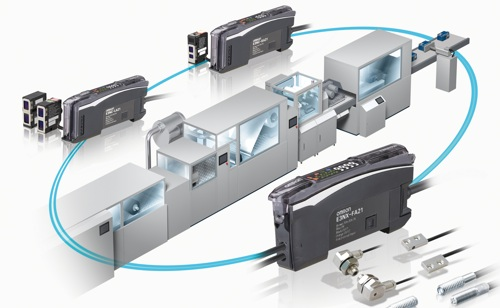 Although sensor technology and performance has advanced at an exponential pace during the last decade, and continues with ever increasing capability, the integration of a sensor often results in a simple digital on/off signal.
Although sensor technology and performance has advanced at an exponential pace during the last decade, and continues with ever increasing capability, the integration of a sensor often results in a simple digital on/off signal.
Whilst many applications would find this adequate, there is so much more that is possible by integrating the operation and configuration of sensors into the machine control platform.
Fieldbus technology opens the door to a wide range of possibilities with regards to sensor integration. For instance EtherCat, which is Omron’s preferred fieldbus platform, provides high speed data transfer, with long distance communications. Yet the real benefit of EtherCat is not specific to sensors, as it allows a machine to have a single fieldbus solution for I/O, drives, servos, actuators, pneumatics, vision systems and sensors. For equipment users looking to create a robust process, a networked solution not only provides basic I/O information, but also allows all configuration and measurement data information to be integrated seamlessly with the machine control system.
Integrating sensors through a fieldbus platform also achieves a high speed distributed solution, and importantly unparalleled levels of accuracy when handling the most challenging sensing applications. Omron’s new superior performance fieldbus enabled N-Smart range has been developed using three advancing technologies. The first, Giga Ray 2s, is an Omron technology which utilises a high efficiency light coupling for improved light transmission and reception performance. The second, Smart Noise Reduction, is an advanced light reception algorithm which vastly improves the detection stability of the sensors, and lastly there is the N-Core processor, providing high speed and precision detection with 36bit processing capacity.
N-Smart’s portfolio of three products, which includes advanced fibre optic sensors, long distance diffuse and CMOS BGS laser sensors, can be configured automatically from the machine controller itself. This facility benefits companies with high levels of product changeover, negating the need for manual reconfiguration during changeover periods which eliminates human error, reduces down-time and improves machine efficiency.
As well as reduced wiring time and costs during installation, only with a fully integrated solution can sensor diagnostic information be fed back to the machine controller, resulting in accurate preventative maintenance information and simplifying the identification of detection issues. This new approach puts control back into the hands of the machine builders and end users handling challenging applications.

